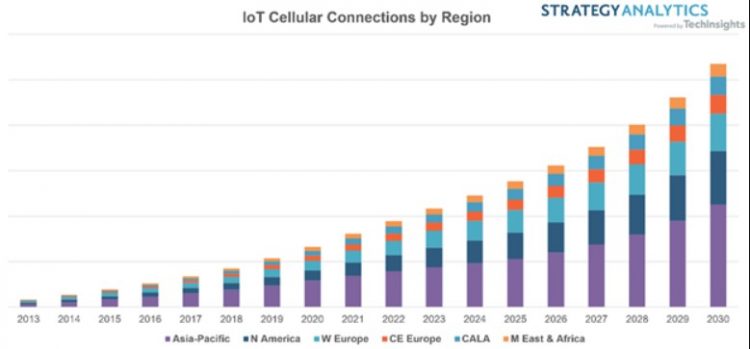Strategy Analytics predicts that cellular IoT will continue to expand until 2030, largely because of the advent of 5G standards optimized for IoT.
In an interview with EE Times, Waseem Haider, principal analyst for IoT initiatives at Strategy Analytics, predicted that “automotive and industrial, together with healthcare,” would be the sectors that most benefited from 5G in 2030. From a meager 1% of IoT links enabled by 5G in 2020, the analytics group projects that by 2030, 5G IoT connections would rise to cover 47% of the overall cellular IoT market.
This implies that 5G connections will be virtually as prevalent as 4G LTE by the end of the decade. By 2030, 4G connections will account for 49% of the cellular IoT market. The two protocols are intended to replace the aging 2G and 3G cellular IoT connections being phased out around the world.

Internet of Things (IoT) advancements are made possible by 5G.
To now, 5G’s impact on the Internet of Things sector has been minimal. Experts claim the 5G ecosystem has barely begun to take shape.
Standalone 5G, which can accommodate 1 million 5G devices in a sq. km., has not yet been rolled out by most mobile operators. That’s a lot more than the maximum of 2,000 devices that can be handled in a square kilometer by a 4G network, and it’s partly why private 5G networks have started to gain traction: they let businesses try out IoT deployments on a grand scale in the safety of their own campus networks.
Business organizations are starting to transition to 5G New Radio-based private networks (5G NR).
Dr. Waseem Haider (Source: Strategy Analytics)
For their 5G Private networks, “all the big automobile OEMs and healthcare providers will be adopting 5G NR,” Haider stated.
Private networks are being used for a wide variety of purposes, including asset tracking, automation, driverless vehicles, spying, and more, he said. Companies like Daimler, Volkswagen, BMW, and others in Germany have already set up LTE/5G private networks and will use 5G RedCap when it becomes available.
A new specification called 5G New Radio Reduced Capability (5G NR RedCap) will allow Internet of Things (IoT) devices like wireless security cameras and fitness trackers to operate over 5G radio networks. In March, as part of 3GPP’s final 5G Release 17 specification, the first RedCap spec was finalized.
RedCap’s first blueprint will result in a chipset that can provide data rates between 30 and 80 Mbps. Costing more than $10, but less than multi-gigabit 5G processors, is likely. In the middle of 2023, these RedCap chips will be available for purchase.
Then, in Release 18 of the 3GPP standard, we’ll see the Enhanced RedCap (eRedCap) specification. A greater data transmission rate and direct device-to-device connections for connected automobiles and other IoT devices are two examples of how this will “expand on the somewhat restricted capabilities of RedCap,” as explained by Haider.
In 2024, we anticipate freezing Release 18. In 2025, businesses will launch eRedCap chipset development, with subsequent commercial releases in 2026.
 Tech Gadget Central Latest Tech News and Reviews
Tech Gadget Central Latest Tech News and Reviews




